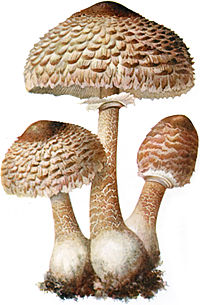Parasol
Macrolepiota proceraSummary 5
The parasol mushroom (Macrolepiota procera) is a basidiomycete fungus with a large, prominent fruiting body resembling a parasol. It is a fairly common species on well-drained soils. It is found solitary or in groups and fairy rings in pastures and occasionally in woodland. Globally, it is widespread in temperate regions.
Macrolepiota procera 6
The parasol mushroom (Macrolepiota procera or Lepiota procera) is a basidiomycetefungus with a large, prominent fruiting body resembling a parasol. It is a fairly common species on well-drained soils. It is found solitary or in groups and fairy rings in pastures and occasionally in woodland. Globally, it is widespread in temperateregions.
Description[edit]
The height and cap diameter of a mature specimen may both reach 40 cm, a size truly impressive for the fruiting body of an agaric. The stipe is relatively thin and reaches full height before the cap has expanded. The stipe is very fibrous in texture which renders it inedible. The surface is characteristically wrapped in a snakeskin-like pattern of scaly growths (therefore, known in some parts of Europe as the "snake's hat" or "snake's sponge"). The immature cap is compact and egg-shaped, with the cap margin around the stipe, sealing a chamber inside the cap. As it matures, the margin breaks off, leaving a fleshy, movable ring around the stipe. At full maturity, the cap is more or less flat, with a chocolate-brown umbo in the centre that is leathery to touch. Dark and cap-coloured flakes remain on the upper surface of the cap and can be removed easily. The gills are crowded, free, and white with a pale pink tinge sometimes present. The spore print is white. It has a pleasant nutty smell. When sliced, the white flesh may turn a pale pink.
Uses[edit]
It is a very sought after and popular fungus in Europe, due in part to its large size, seasonal frequency and versatility in the kitchen. In the UK, it may be found from July through to November.
The parasol mushroom is difficult to mistake for any other, especially in regions like Europe where the poisonous look-alike Chlorophyllum molybdites does not occur. Nevertheless, as with picking any fungus for consumption, caution should be exercised at all times.
The parasol mushroom may not be eaten raw, because it is slightly toxic.
These mushrooms are popular food item when sauteed in melted butter. In central and eastern European countries this mushroom is usually prepared similarly to a cutlet. It is usually run through egg and breadcrumbs and then fried in a pan with some oil or butter. Served with white bread, it makes a delicious meal during summer and early fall.[1] A savory Slovak recipe is to bake caps stuffed with ground pork, oregano, and garlic. Italians and Austrians also serve the young, still spherical caps stuffed with seasoned minced beef, baked in the same manner as stuffed peppers.
Similar species[edit]
Smaller but similar in appearance is the common shaggy parasol (Chlorophyllum rhacodes.) Its edibility is suspect as it causes mild sickness in some people, especially when eaten raw. One must learn to distinguish the two as their geographical ranges overlap.
Differences from the parasol mushroom include its smaller dimensions, pungent (fruity) and reddening flesh when cut, lack of patterns on its stipe, and very shaggy cap surface.
Macrolepiota mastoidea, a European species, is yet another very large edible mushroom. Its dimensions are generally smaller than that of M. procera and the markings on its stipe less obvious. It is also much rarer.
Species of Agaricus have brown spores and the gills of mature specimens are never white.
There are a few poisonous species which can be mistaken for M. procera.
- Chlorophyllum molybdites, a species that causes the largest number of annual mushroom poisonings in North America due to its close similarity. Faintly green gills and a pale green spore print give it away. Furthermore this mushroom lacks the aforementioned snakeskin pattern that is generally present on the parasol mushroom.[2] Its range is reportedly expanding into Europe.[3]
- Leucocoprinus brunnea, also found in North America, slowly turns brown when sliced.
- White and immature species of Amanita are also a potential hazard. To be sure, one must only pick parasol mushrooms past their button stage. A general rule of thumb with the parasol mushroom as compared to amanita species is that the parasol mushroom has darker flakes on a lighter surface, whereas amanita species have the opposite, lighter flakes (if there are any) on a darker surface, such as the Panther cap.
- The Saffron ParasolCystoderma amianthinum is very much smaller, and not often eaten.
- Lepiota brunneoincarnata is a lepiota species known to have caused mortal intoxications in Spain.
Gallery[edit]
References[edit]
Sources and Credits
- (c) Laurence Livermore, some rights reserved (CC BY-NC), http://www.flickr.com/photos/82012125@N00/2710024768
- (c) Valter Jacinto, some rights reserved (CC BY-NC-SA), https://s.yimg.com/pw/images/en-us/photo_unavailable_l.png
- (c) zaca, some rights reserved (CC BY-SA), https://images.mushroomobserver.org/640/271617.jpg
- (c) licensed media from TrekNature DwCA without owner, some rights reserved (CC BY-NC-SA), http://www.treknature.com/viewphotos.php?l=3&p=80446
- (c) Wikipedia, some rights reserved (CC BY-SA), http://en.wikipedia.org/wiki/Macrolepiota_procera
- (c) Unknown, some rights reserved (CC BY-SA), http://eol.org/data_objects/31960567
















